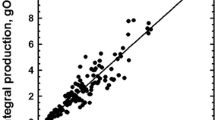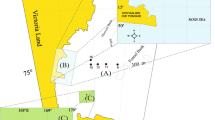Summary
As a means to estimate potential oxygen consumption, profiles of elctron transport system (ETS) activity were made along three transects across the Weddell-Scotia Confluence zone (WSC) and the marginal ice zone (which overlapped in part) during the EPOS leg 2 cruise of the RV Polarstern. The integrated ETS activity between 0 and 100 m depth (referred to in situ temperatures) ranged from 261 meq (mili-electron equivalents) m−2 day−1 in the WSC to 45 meq m−2 day−1 in the southernmost stations at 62° S. The temporal changes in the overall distribution of ETS activity were small compared with the spatial variations. The main feature of the ETS activity distribution was the presence of maxima located in the WSC, coinciding with peaks of phytoplankton biomass. Different relationships between ETS and chlorophyll a concentration in these maxima appeared to be related to diatom or flagellate dominance. Vertically integrated ETS activities were significantly correlated with chlorophyll a and paniculate organic carbon concentrations, primary production and bacterial thymidine uptake.
Similar content being viewed by others
References
Arntz W, Ernst W, Hempel I (1990) The expedition ANTARKTIS VII/4 (EPOS leg 3) and VII/5 of RV “Polarstern” Ber Polarforsch 68:1–214
Bennekom J van, Estrada M, Goeyens L, Magas B, Masson A, Morvan J, Tréguer P, Svansson A, Veth C (1989) Distribution of nutrients in surface, subsurface and deep layers. In: Hempel I, Schalk PH Smetacek V (eds) The expedition ANTARKTIS VII/3 (EPOS leg 2) of the RV “Polarstern” in 1988/1989. Ber Polarforsch 65:47–55
Buma A, Estrada M, Larsen J, Riebesell U, Schloss I, Thomsen HA (1989) Unicellular organisms studied alive using photographic and video techniques. In: Hempel I, Schalk PH, Smetacek V (eds) The expedition ANTaRKTIS VII/3 (EPOS leg 2) of the RV “Polarstern” in 1988/1989. Ber Polarforsch 65:102–110.
Cadée GC (1989) Particulate and dissolved organic carbon. In: Hempel I, Schalk PH, Smetacek V (eds) The expedition ANTARKTIS VII/3 (EPOS leg 2) of the RV “Polarstern” in 1988/1989. Ber Polarforsch 65:101
Cederlöf U, Ober S, Schmidt R, Svansson A, Veth C (1989) Hydrography. In: Hempel I, Schalk PH, Smetacek V (eds) The expedition ANTARKTIS VII/3 (EPOS leg 2) of the RV “Polarstern” in 1988/1989. Ber Polarforsch 65:14–22
Cole JJ, Findlay S, Pace ML (1988) Bacterial production in fresh and saltwater ecosystems: a cross-system overview. Mar Ecol Prog Ser 43:1–10
EPOS-Leg 2 (1989) Data report hydrography. Part 1. NIOZ, The Netherlands
Fogg GE (1977) Aquatic primary production in the Antarctic. Philos Trans R Soc London, (B) Biol Sci 279:27–38
Fuhrman A, Eppley RW, Hagstrom A, Azam F (1985) Diel variations in bacterioplankton, phytoplankton and related parameters in the Southern California Bight. Mar Ecol Prog Ser 27:9–20
Harrison WG (1986) Respiration and its size-dependence in microplankton populations from surface waters of the Canadian Arctic. Polar Biol 6:145–152
Hempel I (1989) The expedition ANTARKTIS VII/1 and 2 (EPOS 1) of RV “Polarstern” in 1988/1989. Ber Polarforsch 62:1–185
Hempel I, Schalk PH, Smetacek V (1989) The expedition ANTARKTIS VII/3 (EPOS leg 2) of RV “Polarstern” in 1988/89. Ber Polarforsch 65:1–199
Hochachka PW, Somero GN (1973) Strategies of biochemical adaptation. WB Saunders, Philadelphia, 358 pp
Jacques G, Panouse M (1989) Phytoplankton biomass distribution. In: Hempel I, Schalk PH, Smetacek V (eds) The expedition Antarktis VII/3 (EPOS leg 2) of the RV “Polarstern” in 1988/1989. Ber Polarforsch 65:61–67
Jacques G, Panouse M (1991) Biomass and composition of size fractionated phytoplankton in the Weddell-Scotia Confluence area. Polar Biol 11:315–328
Kenner RA, Ahmed SL (1975) Measurement of electron transport activities in marine phytoplankton. Mar Biol 33:119–128
Lancelot C, Mathot S (1985) Biochemical fractionation of primary production by phytoplankton in Belgian coastal waters during short-term incubation with 14C-bicarbonate. Mar Biol 86:219–226
Lancelot C, Billen G, Mathot S (1989) Ecophysiology of phyto-and bacterioplankton in the Southern Ocean. In: Caschetto S (ed) Belgian Scientific Research Programme on Antarctica, Scientific Results of Phase 1 (Oct 85–Jan. 89). Plankt Ecol 4–92
Lancelot C, Veth C, Mathot S (1991) Modelling-ice edge phytoplankton bloom in the Scotia-Weddell Sea sector of the Southern Ocean during spring 1988. J Mar Syst 2:333–346
Longhurst AR, Platt T, Harrison WG, Head EJH, Herman AW, Horne E, Conover RJ, Li WKW, Subba Rao DV, Sameoto D, Smith JC, Smith REH (1989) Biological oceanography in the Canadian High Arctic. Rapp P-V Reun Cons Int Explor Mer 188:80–89
Magas B, Svansson A (1989) Optics. In: Hempel I, Schalk PH Smetacek V (eds) The expedition ANTARKTIS VII/3 (EPOS leg 2) of the RV “Polarstern” in 1988/1989. Ber Polarforsch 65:20–24
Margalef R (1978) Life-forms of phytoplankton as survival alternatives in an unstable environment. Oceanol Acta 1:493–509
Martinez R (in press) Biomass and respiratory activity of microplankton in the Barents Sea. Polar Res 10:□
Mathot S, Dandois J-M Lancelot C (in press) Gross and net primary production in the Scotia-Weddell Sea sector of the Southern Ocean during Spring 1988. Polar Biol
Packard TT (1969) The estimation of the oxygen utilization rate in seawater from the activity of the respiratory electron transport system in marine phytoplankton. Limnol Oceanogr 16:60–70
Packard TT (1971) The measurement of electron transport activity in marine phytoplankton. J Mar Res 29:235–244
Packard TT (1979) Respiration and respiratory electron transport activity in plankton from the Northwest African upwelling area. J Mar Res 37:711–742
Packard TT (1985) Measurement of electron transport activity of microplankton. Adv Aquat Microbiol 3:207–261
Packard TT, Devol AH, King FD (1975) The effect of temperature on the respiratory electron transport system in marine plankton. Deep-Sea Res 22:237–249
Packard TT, Williams PJ le B (1981) Rates of respiratory oxygen consumption and electron transport in surface seawater from the northwest Atlantic. Oceanol Acta 4:351–358
Pamatmat M (1989) Oxygen production and uptake; hydrogen peroxyde. In: Hempel I, Schalk PH, Smetacek V (eds) The expedition ANTARKTIS VII/3 (EPOS leg 2) of the RV “Polarstern” in 1988/1989. Ber Polarforsch 65:25–33
Ricker WE (1973) Linear regressions in fishery research. J Fish Res Board Can 30:409–434
Smayda TJ (1980) Phytoplankton species succession. In: Morris I (ed) The physiological ecology of phytoplankton. Blackwell Scientific Publications, Oxford, pp 493–570
Steemann-Nielsen E (1952) The use of radio-active carbon (14C) for measuring organic production in the sea. J Cons Int Explor Mer 18:117–140
Strickland JDH (1965) Production of organic matter in the primary stages of the marine food chain. In: Riley JP, Skirrow G (eds) Chemical oceanography. Academic Press, New York, 606 pp
Van Es FB, Meyer-Reil LA (1982) Biomass and metabolic activity of heterotrophic marine bacteria. Adv Microbiol Ecol 6:111–170
Vosjan JH (1982) Respiratory electron transport system activities in marine environments. Hydrobiol Bull 16:61–68
Vosjan JH, Niewland G (1987) Microbial biomass and respiratory activity in the surface water of the east Banda Sea and Northwest Arafura Sea (Indonesia) at the time of the southeast monsoon. Limnol Oceanogr 32:767–775
Vosjan JH, Bak RPM, Nieuwland G (1990) Microbial characteristics in water and sediment of the estern Weddell Sea. In: Arntz W, Ernst W, Hempel I (1990) The expedition ANTARKTIS VII/4 (EPOS leg 3) and VII/5 of RV “Polarstern”. Ber Polarforsch 68:67–72
White PA, Kalff J, Rasmussen JB, Gasol JM (1991) The effect of temperature and algal biomass on bacterial production and specific growth rate in freshwater and marine habitats. Microbial Ecol 21:99–118
Williams PJ le B (1984) A review of measurements of respiration rates of marine plankton populations. In: Hobbie JE, Williams PJ le B (eds) Heterotrophic activity in the sea. Plenum Press, New York, pp 357–390
Author information
Authors and Affiliations
Additional information
Data presented here were collected during the European Polarstern Study (EPOS) sponsored by the European Science Foundation
Rights and permissions
About this article
Cite this article
Estrada, M., Martinez, R. & Mathot, S. Respiratory electron transport activity in plankton of the Weddell and Scotia Seas during late spring — early summer: relationships with other biological parameters. Polar Biol 12, 35–42 (1992). https://doi.org/10.1007/BF00239963
Received:
Accepted:
Issue Date:
DOI: https://doi.org/10.1007/BF00239963




